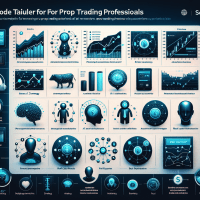Solvent.Life vs Vantir: AI Strategy and Its Impact on Prop Trading
Prop trading firms are evolving rapidly by integrating cutting-edge AI strategies and feedback models to enhance decision-making and manage risk effectively. In this article, we break down the differences between Solvent.Life and Vantir, offering a deep dive into their AI strategies, feedback mechanisms, and how they support advanced backtesting in a proprietary trading environment.
Introduction to AI Strategies in Prop Trading
In today’s competitive markets, AI-driven trading platforms are indispensable for both retail traders and institutional prop trading firms. Firms are increasingly relying on automated backtesting, walk-forward optimization, and advanced risk management tools to improve execution speed and accuracy. This comparison specifically evaluates Solvent.Life and Vantir, two leading platforms known for their AI strategies and feedback models.
Understanding the Core Differences: AI Strategy vs AI Feedback Models
Both Solvent.Life and Vantir offer robust AI frameworks, yet they differ in focus. Solvent.Life emphasizes strategic model development for predictive analytics, while Vantir specializes in iterative feedback mechanisms that refine trading signals. Here’s a closer look:
Solvent.Life: AI Strategy and Predictive Analytics
- Backtesting Features: Uses vectorized backtesting with automated parameter optimization, ensuring commission and slippage are modeled accurately.
- Data Quality: Provides deep historical data sets across multiple asset classes and integrates real-time feeds from major exchanges.
- Integration Capabilities: Offers robust API access, easy broker integration, and compatibility with platforms such as TradingView and NinjaTrader.
- Pricing Tiers: Includes trial options with tiered pricing based on feature access; ideal for firms scaling from retail to institutional trading.
- Use Cases: Best suited for prop firms seeking deep analytical insights and automated strategy optimizations.
- Automation Features: Automates complex backtesting algorithms, providing detailed scenario analyses and stress testing capabilities.
Vantir: AI Feedback Models and Signal Refinement
- Backtesting Features: Provides event-driven backtesting that adapts to market changes with built-in error corrections and slippage calculations.
- Data Quality: Focuses on high-frequency data with accurate tick-level detail, covering a diverse portfolio from equities to derivatives.
- Integration Capabilities: Seamlessly integrates with broker APIs and other analytical platforms like MetaTrader 5 and QuantConnect.
- Pricing Tiers: Competitive pricing with free trial periods; structured for continuous feedback loops and iterative learning processes.
- Use Cases: Designed for teams requiring real-time feedback for rapid strategy adjustments and error minimization in high-volatility markets.
- Automation Features: Automates the feedback process, allowing for dynamic adaptation of trading strategies based on ongoing performance analysis.
Advanced Backtesting in Prop Trading
Backtesting is a critical element in developing and fine-tuning AI-driven trading strategies. Both platforms address this need, though differently:
Mitigating Common Backtesting Pitfalls
Successful backtesting requires overcoming challenges such as overfitting, survivorship bias, look-ahead bias, and data snooping. Here are key strategies used by top prop trading firms:
- Overfitting Avoidance: Use walk-forward optimization to separate training data from validation sets.
- Survivorship Bias: Incorporate surviving and non-surviving assets in historical data sets.
- Look-Ahead Bias: Ensure that only data available at the time of the trade is used.
- Data Snooping: Regularly update and validate models using out-of-sample testing.
Walk-Forward Optimization vs. Traditional Backtesting
Walk-forward optimization is a dynamic approach where a model is repeatedly calibrated with a rolling time frame. This method contrasts with traditional backtesting by allowing more accurate real-time simulation. For prop trading, this means:
- Continuous calibration of AI models with fresh market data.
- Enhanced detection of market regime shifts and anomalies.
- Integration of stress testing and scenario analysis.
Out-of-Sample Testing and Forward Integration
Out-of-sample testing is essential to validate AI model robustness before live deployment. Prop trading firms often combine backtesting with paper trading to fine-tune strategies in a risk-free environment. Key metrics to monitor include:
- Sharpe Ratio: A target above 1.5 is typically desired.
- Maximum Drawdown: Strict drawdown limits are set to ensure risk is controlled.
- Profit Factor: A profit factor greater than 1.5 is indicative of a robust strategy.
Tool Comparison Table
Below is a comparison of three widely recognized automated backtesting and prop trading tools:
| Tool | Backtesting Features | Data Availability | Integration | Pricing | Use Cases |
|---|---|---|---|---|---|
| TradingView | Vectorized, commission/slippage integration, scenario analysis | Extensive historical and real-time data | APIs and broker plugins | Freemium; tiered subscriptions | Retail traders to prop firms needing visual, flexible charting |
| NinjaTrader | Event-driven analysis, robust optimization modules | High-frequency data feeds for futures and forex | Broker integration and custom scripting | One-time license and subscription options | Active traders and prop firms focusing on futures trading |
| QuantConnect | Algorithmic backtesting with integrated parameter optimization | Comprehensive data coverage across asset classes | API integrations with Interactive Brokers and others | Free for basic open-source, paid tiers available | Quantitative trading teams and prop firms requiring scalable strategies |
Case Study: Real-World Application in a Prop Trading Firm
Consider a mid-sized prop trading firm that integrated Solvent.Life for its strategic model development. The firm faced challenges with overfitting using traditional backtesting methods. By adopting walk-forward optimization and integrating out-of-sample tests, the firm’s Sharpe ratio improved from 1.2 to 1.8, while maximum drawdown was reduced by 25% over a six-month period.
Conversely, a firm using Vantir’s AI feedback model encountered rapid market fluctuations. Their system, leveraging real-time tick data and dynamic feedback loops, allowed them to adjust signals on-the-fly, which minimized execution errors and improved overall profit factors. Detailed case study reports provided by Vantir showed iteration times reduced by 30%, leading to decisive competitive advantages.
Integrating Automated Backtesting with Live Trading
To transition from backtesting to live deployment, firms must integrate automated strategies with paper trading environments. A typical workflow might include:
- Complete ethical backtesting with historical data ensuring all common pitfalls are addressed.
- Conduct walk-forward analysis to simulate dynamic market conditions.
- Engage in out-of-sample testing followed by controlled paper trading.
- Monitor key performance metrics such as Sharpe ratio and drawdown in real-time.
Practical Example: Python Backtrader Code Snippet
import backtrader as bt
class MyStrategy(bt.Strategy):
def __init__(self):
self.sma = bt.indicators.SimpleMovingAverage(self.data.close, period=20)
def next(self):
if self.data.close[0] > self.sma[0]:
self.buy()
elif self.data.close[0] < self.sma[0]:
self.sell()
cerebro = bt.Cerebro()
data = bt.feeds.YahooFinanceData(dataname='AAPL', fromdate=bt.date2num(bt.date2num(bt.date2num(bt.datetime(2018, 1, 1)))), todate=bt.datetime(2019, 1, 1))
cerebro.adddata(data)
cerebro.addstrategy(MyStrategy)
results = cerebro.run()
print('Final Portfolio Value: %.2f' % cerebro.broker.getvalue())
Regulatory Considerations in Prop Trading
While advanced backtesting and AI strategies transform prop trading, firms must adhere to regulatory guidelines such as MiFID II, ESMA regulations, and NFA rules. Compliance tools provided by platforms like QuantConnect and NinjaTrader help ensure that risk management procedures are robust and transparent.
Internal Linking and Supplementary Resources
For more insights on optimizing your trading framework, consider exploring our detailed Risk Management Checklist and our comprehensive Quantitative Strategy Guide. These resources offer actionable steps and further examples to streamline your strategy development process.
Conclusion and Next Steps
Understanding the differences between Solvent.Life and Vantir’s AI models can empower prop trading firms to adopt the best practices in strategy development and risk management. Whether you are a junior trader or a senior quant, mastering advanced backtesting techniques, walk-forward optimization, and integrating real-time feedback mechanisms are keys to sustainable trading success.
As of October 2023, the utilization of these advanced methodologies is reshaping the prop trading landscape. We encourage you to experiment with these tools, refine your models, and leverage the case studies and resources provided to boost your trading performance.
Next Step: Download our complete Risk Management Checklist below, and join our upcoming webinar on advanced backtesting integration techniques to further enhance your prop trading strategies.
Risk Management Checklist
This checklist includes:
- Key metrics to monitor (Sharpe Ratio, Maximum Drawdown, Profit Factor)
- Steps for mitigating common backtesting pitfalls
- Guidelines for effective out-of-sample and forward testing
- Integration points for combining automated backtesting with paper trading
Using this checklist can provide a roadmap for integrating reliable risk management within your prop trading strategy.







